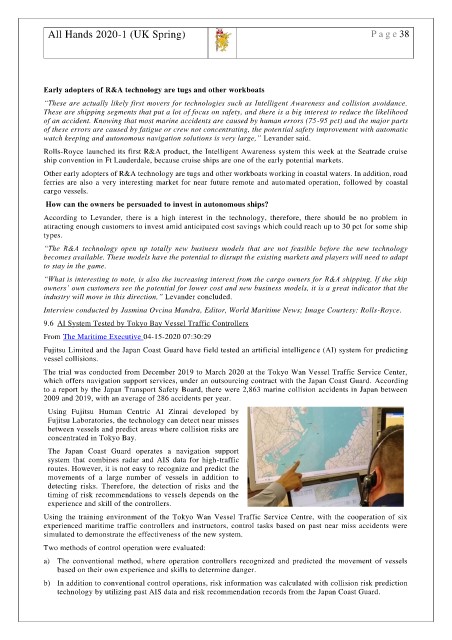Page 40 - D:\AA Warsash Association\Journals\2020\AH2020-1\DEK\
P. 40
All Hands 2020-1 (UK Spring) P a g e 38
Early adopters of R&A technology are tugs and other workboats
“These are actually likely first movers for technologies such as Intelligent Awareness and collision avoidance.
These are shipping segments that put a lot of focus on safety, and there is a big interest to reduce the likelihood
of an accident. Knowing that most marine accidents are caused by human errors (75-95 pct) and the major parts
of these errors are caused by fatigue or crew not concentrating, the potential safety improvement with automatic
watch keeping and autonomous navigation solutions is very large,” Levander said.
Rolls-Royce launched its first R&A product, the Intelligent Awareness system this week at the Seatrade cruise
ship convention in Ft Lauderdale, because cruise ships are one of the early potential markets.
Other early adopters of R&A technology are tugs and other workboats working in coastal waters. In addition, road
ferries are also a very interesting market for near future remote and automated operation, followed by coastal
cargo vessels.
How can the owners be persuaded to invest in autonomous ships?
According to Levander, there is a high interest in the technology, therefore, there should be no problem in
attracting enough customers to invest amid anticipated cost savings which could reach up to 30 pct for some ship
types.
“The R&A technology open up totally new business models that are not feasible before the new technology
becomes available. These models have the potential to disrupt the existing markets and players will need to adapt
to stay in the game.
“What is interesting to note, is also the increasing interest from the cargo owners for R&A shipping. If the ship
owners’ own customers see the potential for lower cost and new business models, it is a great indicator that the
industry will move in this direction,” Levander concluded.
Interview conducted by Jasmina Ovcina Mandra, Editor, World Maritime News; Image Courtesy: Rolls-Royce.
9.6 AI System Tested by Tokyo Bay Vessel Traffic Controllers
From The Maritime Executive 04-15-2020 07:30:29
Fujitsu Limited and the Japan Coast Guard have field tested an artificial intelligence (AI) system for predicting
vessel collisions.
The trial was conducted from December 2019 to March 2020 at the Tokyo Wan Vessel Traffic Service Center,
which offers navigation support services, under an outsourcing contract with the Japan Coast Guard. According
to a report by the Japan Transport Safety Board, there were 2,863 marine collision accidents in Japan between
2009 and 2019, with an average of 286 accidents per year.
Using Fujitsu Human Centric AI Zinrai developed by
Fujitsu Laboratories, the technology can detect near misses
between vessels and predict areas where collision risks are
concentrated in Tokyo Bay.
The Japan Coast Guard operates a navigation support
system that combines radar and AIS data for high-traffic
routes. However, it is not easy to recognize and predict the
movements of a large number of vessels in addition to
detecting risks. Therefore, the detection of risks and the
timing of risk recommendations to vessels depends on the
experience and skill of the controllers.
Using the training environment of the Tokyo Wan Vessel Traffic Service Centre, with the cooperation of six
experienced maritime traffic controllers and instructors, control tasks based on past near miss accidents were
simulated to demonstrate the effectiveness of the new system.
Two methods of control operation were evaluated:
a) The conventional method, where operation controllers recognized and predicted the movement of vessels
based on their own experience and skills to determine danger.
b) In addition to conventional control operations, risk information was calculated with collision risk prediction
technology by utilizing past AIS data and risk recommendation records from the Japan Coast Guard.

